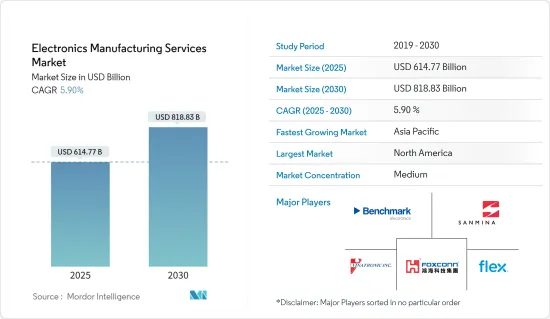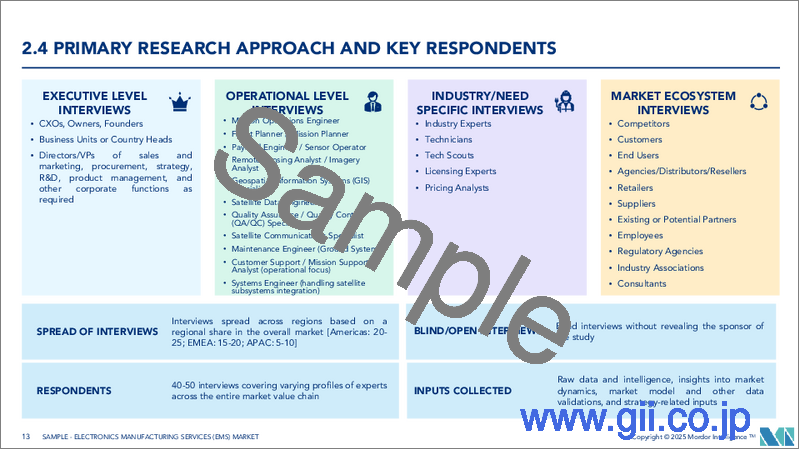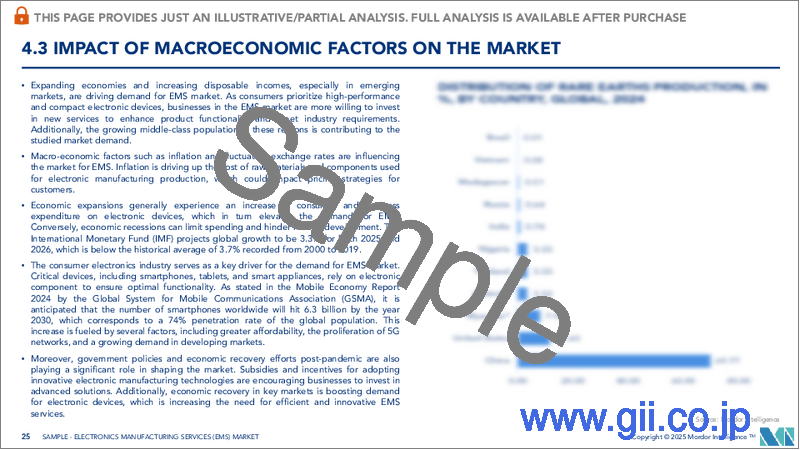|
|
市場調査レポート
商品コード
1643079
電子機器製造サービス:市場シェア分析、産業動向・統計、成長予測(2025年~2030年)Electronics Manufacturing Services - Market Share Analysis, Industry Trends & Statistics, Growth Forecasts (2025 - 2030) |
||||||
カスタマイズ可能
適宜更新あり
|
|||||||
| 電子機器製造サービス:市場シェア分析、産業動向・統計、成長予測(2025年~2030年) |
|
出版日: 2025年01月05日
発行: Mordor Intelligence
ページ情報: 英文 120 Pages
納期: 2~3営業日
|
全表示
- 概要
- 目次
概要
電子機器製造サービス市場規模は、2025年に6,147億7,000万米ドルと推定され、予測期間(2025-2030年)のCAGRは5.9%で、2030年には8,188億3,000万米ドルに達すると予測されます。

主なハイライト
- 産業用モノのインターネット(IIoT)における小型化と新技術の採用が進み、5Gによって通信が強化されたことで、電子部品の設計と組み立てに革命が起きています。例えば、5G用の通信基地局は、MIMOなどの優れたアンテナ技術を開発し、放射素子の数と性能の上昇につながった。
- さらに、スマートフォンやスマートウォッチなどの電子機器の需要が市場の成長を後押ししています。IBEFによると、インドの家電・民生用電子機器産業は、2025年までに2倍以上の211億8,000万米ドルに達すると予想されています。さらに、多くの企業が製造活動における在庫、施設、設備を削減しようとし、設備投資の重点を販売、マーケティング、研究開発に移しています。このため、第三者製造サービス・プロバイダーへのアウトソーシング需要が高まっています。
- 例えば、あるアビオニクス企業は、製品とサービスの提供範囲を広げ、製造への追加投資を行わないために、PCBAの製造をEMSパートナーに移管することを決定しました。主な要件は、AS9100規格への準拠と、PCBA上の複数のBGA(一部のPCBでは最大16層)でした。
- 様々な地域における政府の取り組みが、市場の成長を後押ししています。例えば、IBEFが報告したように、インド政府はITハードウェア生産連動奨励金(PLI)制度に14社を認可しました。さらに、インド政府はエレクトロニクスの設計・製造に100%のFDIを認可し、マルチブランド小売のFDI上限を現在の49%から51%に引き上げることを検討しています。これらの動きは、市場の成長を大きく後押しするものです。
- 世界的に、中小企業や中堅中小企業がサードパーティの製造サービスを利用する傾向が強まっています。このシフトにより、生産ラインへの多額の設備投資を回避し、サービス・プロバイダーの設計や製造の専門知識を活用することができます。国際金融公社(IFC)によると、開発途上国の正規の零細・中小企業の約40%にあたる6,500万社が、満たされていない金融ニーズに直面していると推定されています。世界の、特に新興国の企業の大半が中小企業のカテゴリーに入ることを考えると、製造サービス・プロバイダーへの依存はEMS市場の成長を下支えすることになると思われます。
- COVID-19の流行は多くのエンドユーザー産業に大きな影響を与えたが、エレクトロニクス製造業も例外ではありません。IPCの調査によると、中国の製造能力とサプライチェーンへの依存度が高いことから、家電製品が影響を受けたことが浮き彫りになった。にもかかわらず、多くの電子機器メーカーと関連サービスは、製品の組み立てから重要な医療機器の回路基板の設計に至るまで、極めて重要な役割を担っていることから、必要不可欠であるとみなされました。ポストCOVID時代においても、エレクトロニクス製造業は経済とヘルスケア分野の両輪であり続ける構えです。
電子機器製造サービス市場の動向
産業用途がEMS需要を牽引する見通し
- 環境革命の高まりに伴い、電気モーター制御は産業用モーターにより高い効率を要求しています。さらに、新技術の市場浸透をサポートし、安全性と信頼性を向上させるために、最低コストでの統合化が求められています。このため、スマートモーターの電圧制御用デジタル信号コントローラーに使用される電子製品の需要がさらに高まっています。
- IBEFによると、インドの電気自動車(EV)市場は2025年までに70億9,000万米ドルに達すると推定されています。さらに、CEEW Centre for Energy Financeの調査では、2030年までにインドにおける電気自動車のビジネスチャンスは2,060億米ドルに達すると認識されています。
- インダストリー4.0は、工場データの自動化効率と生産性の大幅な向上を保証します。産業用IoTと人工知能(AI)の並行的な進歩が成長を促進します。エレクトロニクス産業が同レベルのインテリジェンスと自動化を達成するには程遠いとはいえ、インダストリー4.0に向けた進化が道を開きつつあることは、電子機器製造サービス市場の最近の動向からも明らかです。
- IBM AI Global Adoption Indexによると、2023年、組織におけるAI導入の主な促進要因の1つはコスト削減とプロセスの自動化であり、要因の42%を占めています。産業オートメーションは、電子製造サービス市場の成長を促進します。AIの拡大は、AIツールのアクセシビリティの向上、プロセス自動化の推進、主流ビジネスアプリケーションへのAIの統合によってさらに促進されます。
- ロックウェル・オートメーションは最近、電気パネル構築用のモジュラー・システムを専門とするCUBICを買収する最終契約を締結しました。この協業は、市場投入までの時間を短縮し、インテリジェント・モーター制御のためのより広範な工場全体のアプリケーションを可能にし、幅広い顧客の持続可能性と生産性を向上させるスマートデータを生成することで、企業に利益をもたらすと期待されています。
- 産業オートメーション用エレクトロニクスの製造は、このセグメントの成長に拍車をかけています。産業オートメーション分野のプレーヤーは、システムによって生成されたすべてのデータへの一貫したアクセスを必要としています。しかし、多くの業務用ユーティリティ・アプリケーションの範囲が広いため、このレベルのデータ取得は複雑です。欧州や北米のような地域では、正確なデータ収集のために監視制御およびデータ収集(SCADA)の導入が進んでいます。
- ほとんどのSCADAシステムは、シングルボードリモートターミナルユニット(RTU)で構成され、すべての入出力(I/O)モジュールを単一のプリント回路基板上に配置したコンパクトで堅牢な製品です。したがって、ユーティリティ分野でのSCADA展開の増加は、EMSの需要をさらに押し上げます。
アジア太平洋が大きな成長を遂げる見込み
- アジア太平洋市場は予測期間中に大きく成長すると予想されます。インドと中国は、家電、半導体、その他の通信機器・装置製造業界で確固たる地位を築いているため、世界的にEMSの強力な市場となっています。例えば、タタ・グループは半導体製造事業への参入計画を発表し、1兆米ドル規模のハイテク・エレクトロニクス製造部門への参入を目指しています。
- さらに、5GネットワークやIoTの展開といった技術の変化が、電子製品の採用を加速させています。デジタル・インド」や「スマート・シティ」プロジェクトなどの取り組みが、電子機器におけるIoTの需要を高めています。
- インド電子工業会(Electronic Industries Association Of India)によると、同国の電子機器受託製造部門は2025年までに6倍以上に成長し、約1,520億米ドルに達すると予想されています。また、同国は2025年までに携帯電話だけで約1,000億米ドルの輸出目標を掲げており、政府の生産連動型奨励金(PLI)制度の支援により実現が期待されています。
- IBEFによると、同国の製造業を奨励するPLIスキームの約80%は、14の企業を対象とし、投資総額は389億9,000万米ドルで、エレクトロニクス、自動車、ソーラーパネル製造の3部門のみに集中しています。この拡大は、ネットワーキング、5G、データセンター、自動車/LIDAR、航空宇宙・防衛市場にまたがる新技術製品の急成長を支えています。
- APACのサプライチェーンは、製品の設計から始まり、半導体の製造とパッケージング、コンポーネントとサブシステム、最終組立、テストに至るまで、製造コストを削減するために、インドやインドネシアを含むAPACの低コスト国へと徐々に移行しています。例えば、コスト上昇と以前の貿易摩擦により、台湾のペガトロンはベトナムやインドネシアといった国への生産分散を余儀なくされました。このような貿易摩擦による不確実性から、アジアの多くの企業が投資を再調整し、関税を回避するために製造拠点をシフトしました。
電子機器製造サービス業界の概要
電子機器製造サービス市場は、各業界でサービスの導入が進んでいることと、世界的に複数の市場プレーヤーが存在していることから、半固体化しています。市場プレイヤーは、製品開拓とイノベーションを市場拡大の有利な道と見なしています。
- 2024年1月世界の電子機器製造サービスのスペシャリティ・プロバイダーであるクリエーション・テクノロジーズは、オンタリオ州マーカムに拡張施設を発表しました。新拠点の敷地面積は11万8,500平方フィートで、以前の拠点に比べ54%拡大しました。この拡張は、高品質の電子機器製造サービスを提供する能力を強化し、顧客の高まる需要に応え、長期的な成長戦略をサポートすることを目的としています。
- 2024年5月テクノロジー大手のシーメンスAGと、フォックスコンとして知られる鴻海(ホンハイ)科技集団が覚書に調印。両社の目標は、エレクトロニクス、ICT、電気自動車に特に重点を置いたスマート製造におけるデジタルトランスフォーメーションと持続可能性を先導することです。この協業により、効率的なエンジニアリングと製造のエコシステムが確立されます。シーメンスとフォックスコンは、それぞれの専門知識を組み合わせることで、革新的なソリューションを生み出し、世界な製造プロセスの進歩を促進し、より持続可能で技術的に進んだ未来を実現することを目指しています。
その他の特典
- エクセル形式の市場予測(ME)シート
- 3ヶ月間のアナリストサポート
目次
第1章 イントロダクション
- 調査の前提条件と市場定義
- 調査範囲
第2章 調査手法
第3章 エグゼクティブサマリー
第4章 市場力学
- 市場概要
- 業界の魅力度-ポーターのファイブフォース分析
- 供給企業の交渉力
- 買い手の交渉力
- 新規参入業者の脅威
- 代替品の脅威
- 競争企業間の敵対関係
- 市場促進要因
- 小型化の動向の高まり
- IIoT(産業用モノのインターネット)、ブロックチェーン、通信強化における新技術の採用
- 市場の課題
- 競争の激化と厳しい政府・環境規制
- 知的財産権の侵害
- COVID-19が市場に与える影響の評価
第5章 市場セグメンテーション
- サービスタイプ別
- エレクトロニクス設計とエンジニアリング
- エレクトロニクス組立
- エレクトロニクス製造
- その他のサービスタイプ
- 用途別
- コンシューマーエレクトロニクス
- 自動車
- 産業用
- 航空宇宙・防衛
- ヘルスケア
- ITおよび電気通信
- その他の用途
- 地域別
- 北米
- 米国
- カナダ
- 欧州
- 英国
- イタリア
- ドイツ
- フランス
- その他欧州
- アジア太平洋
- 中国
- 台湾
- 日本
- 韓国
- インド
- その他アジア太平洋地域
- ラテンアメリカ
- 中東・アフリカ
- 北米
第6章 競合情勢
- 企業プロファイル
- Vinatronic Inc.
- Benchmark Electronics Inc.
- Hon Hai Precision Industry Co. Ltd(Foxconn)
- Flex Ltd
- Sanmina Corporation
- Jabil Inc.
- SIIX Corporation
- Nortech Systems Incorporated
- Celestica Inc.
- Integrated Micro-electronics Inc.
- Creation Technologies LP
- Wistron Corporation
- Plexus Corporation
- TRICOR Systems Inc.
- Sumitronics Corporation
第7章 投資分析
第8章 市場の将来
目次
Product Code: 69610
The Electronics Manufacturing Services Market size is estimated at USD 614.77 billion in 2025, and is expected to reach USD 818.83 billion by 2030, at a CAGR of 5.9% during the forecast period (2025-2030).

Key Highlights
- With increasing miniaturization and adoption of emerging technologies in the Industrial Internet of Things (IIoT) and enhanced communication posed by 5G, electronic component design and assembly have been revolutionized. For instance, the communication base stations for 5G developed a superior antenna technology, such as MIMO, leading to a rise in the number and performance of radiating elements.
- Additionally, the demand for electronic devices, such as smartphones, smartwatches, and other devices, has boosted the market's growth. According to IBEF, the Indian appliances and consumer electronics industry is anticipated to more than double, reaching USD 21.18 billion by 2025. Further, many companies seek to lower their inventory, facilities, and equipment in their manufacturing activities, shifting the focus of their capital investments toward sales, marketing, and R&D. This has increased the demand for outsourcing to third-party manufacturing service providers.
- For instance, an avionics company decided to transfer its PCBA production to an EMS partner to broaden its product and service offerings and not make an additional investment in manufacturing. The primary requirements were compliance with AS9100 standards and multiple BGAs on the PCBAs, with up to 16 layers on some PCBs.
- Government initiatives across various regions are propelling market growth. For example, as reported by IBEF, the Indian government greenlit 14 companies for the IT hardware production-linked incentive (PLI) scheme. Additionally, the Indian government sanctioned 100% FDI in electronics design and manufacturing, and it is considering raising the FDI cap for multi-brand retail to 51%, up from the current 49%. These moves are poised to significantly boost market growth.
- Globally, SMEs and MSMEs are increasingly turning to third-party manufacturing services. This shift allows them to sidestep hefty capital investments in production lines and tap into the design and manufacturing expertise of service providers. According to the International Finance Corporation (IFC), an estimated 65 million firms, roughly 40% of formal micro, small, and medium enterprises in developing nations, face unmet financial needs. Given that the majority of businesses worldwide, especially in developing nations, fall under the SME category, their reliance on manufacturing service providers is set to underpin the EMS market's growth.
- The COVID-19 pandemic significantly affected numerous end-user industries, and electronics manufacturing was no exception. A survey by IPC highlighted that consumer electronics were impacted, given their heavy dependence on China's manufacturing capacity and supply chains. Despite this, many electronics manufacturers and associated services were deemed essential, given their pivotal role in tasks ranging from product assembly to designing circuit boards for vital medical equipment. In the post-COVID era, electronics manufacturing is poised to remain a cornerstone of both the economy and the healthcare sector.
Electronics Manufacturing Services Market Trends
Industrial Applications Are Expected to Drive the Demand for EMS
- With the rising trend of the environmental revolution, electric motor controls are demanding higher efficiency for industrial motors. Furthermore, increased integration at the lowest cost is required to support market penetration of new technologies and improve safety and reliability. This further drives the demand for electronic products used in smart motors' digital signal controllers for voltage control operations.
- According to IBEF, India's electric vehicle (EV) market is estimated to reach USD 7.09 billion by 2025. Further, a study by the CEEW Centre for Energy Finance recognized a USD 206 billion opportunity for electric vehicles in India by 2030.
- Industry 4.0 assures huge gains in factory data automation efficiency and productivity. The parallel advancements in industrial IoT and artificial intelligence (AI) drive growth. Even though the electronics industry is far from achieving the same level of intelligence and automation, the evolution toward Industry 4.0 is paving the way, as evident by recent trends in the electronics manufacturing services market.
- As per the IBM AI Global Adoption Index, in 2023, one of the primary drivers for AI adoption in organizations was cost reduction and process automation, accounting for 42% of the factors. Industrial automation propels growth in the electronic manufacturing services market. AI expansion is further fueled by the rising accessibility of AI tools, a push for process automation, and the integration of AI into mainstream business applications.
- Rockwell Automation Inc. recently signed a definitive contract to acquire CUBIC, which specializes in modular systems for constructing electrical panels. The collaboration is expected to benefit a company by offering faster time to market, enabling broader plant-wide applications for intelligent motor control, and generating smart data to increase sustainability and productivity for a wide range of customers.
- The manufacturing of electronics for industrial automation is fueling the growth of this segment. Players in the industrial automation segment need consistent access to all the data generated by the system. However, because of the scope of many operational utility applications, this level of data acquisition is complicated. Regions like Europe and North America are increasingly deploying Supervisory Control and Data Acquisition (SCADA) for accurate data collection.
- Most SCADA systems consist of single-board remote terminal units (RTUs), compact, ruggedized products that locate all input/output (I/O) modules on a single printed circuit board. Hence, the increasing deployment of SCADA in the utility sector further drives the demand for EMS.
Asia-Pacific is Expected to Witness Major Growth
- The Asia-Pacific market is expected to grow significantly during the forecast period. India and China have strong markets for EMS worldwide, owing to their solid position in the consumer electronics, semiconductor, and other telecommunications devices and equipment manufacturing industries. For instance, Tata Group announced plans to enter the semiconductor manufacturing business, seeking a proportion of the USD 1 trillion high-tech electronics manufacturing sector.
- Moreover, technology changes, such as the rollout of 5G networks and IoT, are driving the accelerated adoption of electronic products. Initiatives such as 'Digital India' and 'Smart City' projects have increased the demand for IoT in electronic devices.
- According to the Electronic Industries Association Of India, the country's electronic contract manufacturing sector is expected to grow more than sixfold to reach around USD 152 billion by 2025. The country has also set a target of approximately USD 100 billion in exports of mobiles alone by 2025, which is expected to be made possible with the support of the government's production-linked incentive (PLI) scheme.
- According to IBEF, about 80% of the PLI scheme to encourage manufacturing in the country, which covers 14 enterprises and has a total investment of USD 38.99 billion, is concentrated in only three sectors: electronics, automobiles, and solar panel production. This expansion supports rapid growth for new technology products across networking, 5G, data center, automotive/LIDAR, and aerospace and defense markets.
- APAC's supply chain starts with product design, semiconductor fabrication and packaging, components and subsystems, final assembly, and testing, which is also slowly moving toward low-cost countries in APAC, including India and Indonesia, to reduce manufacturing costs. For instance, rising costs and previous trade tensions compelled Taiwan's Pegatron to diversify production to countries such as Vietnam and Indonesia. Such uncertainty due to trade tension led many companies in Asia to readjust investments and shift their manufacturing bases to avoid tariffs.
Electronics Manufacturing Services Industry Overview
The electronics manufacturing services market is semi-consolidated, owing to the improved adoption of these services across industries and the presence of several market players globally. Market players view product developments and innovations as a lucrative path for market expansion.
- January 2024: Creation Technologies, a Specialty Global Electronic Manufacturing Services provider, unveiled its expanded facility in Markham, Ontario. The new site, covering 118,500 square feet, is a 54% increase in size compared to its previous location. This expansion aims to enhance the company's capacity to deliver high-quality electronic manufacturing services, meeting the growing demands of its clients and supporting its long-term growth strategy.
- May 2024: Siemens AG, a technology giant, and Hon Hai Technology Group, known as Foxconn, inked a memorandum of understanding (MoU). Their goal is to spearhead digital transformation and sustainability in smart manufacturing, with a particular emphasis on electronics, ICT, and electric vehicles. The collaboration is set to establish an efficient engineering and manufacturing ecosystem. By combining their expertise, Siemens and Foxconn aim to create innovative solutions to drive advancements in global manufacturing processes, ensuring a more sustainable and technologically advanced future.
Additional Benefits:
- The market estimate (ME) sheet in Excel format
- 3 months of analyst support
TABLE OF CONTENTS
1 INTRODUCTION
- 1.1 Study Assumptions and Market Definition
- 1.2 Scope of the Study
2 RESEARCH METHODOLOGY
3 EXECUTIVE SUMMARY
4 MARKET DYNAMICS
- 4.1 Market Overview
- 4.2 Industry Attractiveness - Porter's Five Forces Analysis
- 4.2.1 Bargaining Power of Suppliers
- 4.2.2 Bargaining Power of Buyers
- 4.2.3 Threat of New Entrants
- 4.2.4 Threat of Substitute Products
- 4.2.5 Intensity of Competitive Rivalry
- 4.3 Market Drivers
- 4.3.1 Growing Trends of Miniaturization
- 4.3.2 Adoption of Emerging Technologies in IIoT (Industrial Internet of Things), Blockchain, and Enhanced Communication
- 4.4 Market Challenges
- 4.4.1 Intensifying Competition and Rigorous Government and Environmental Regulations
- 4.4.2 Intellectual Property Rights Infringements
- 4.5 Assessment of the Impact of COVID-19 on the Market
5 MARKET SEGMENTATION
- 5.1 By Service Type
- 5.1.1 Electronics Design and Engineering
- 5.1.2 Electronics Assembly
- 5.1.3 Electronics Manufacturing
- 5.1.4 Other Service Types
- 5.2 By Application
- 5.2.1 Consumer Electronics
- 5.2.2 Automotive
- 5.2.3 Industrial
- 5.2.4 Aerospace and Defense
- 5.2.5 Healthcare
- 5.2.6 IT and Telecom
- 5.2.7 Other Applications
- 5.3 By Geography
- 5.3.1 North America
- 5.3.1.1 United States
- 5.3.1.2 Canada
- 5.3.2 Europe
- 5.3.2.1 United Kingdom
- 5.3.2.2 Italy
- 5.3.2.3 Germany
- 5.3.2.4 France
- 5.3.2.5 Rest of Europe
- 5.3.3 Asia-Pacific
- 5.3.3.1 China
- 5.3.3.2 Taiwan
- 5.3.3.3 Japan
- 5.3.3.4 South Korea
- 5.3.3.5 India
- 5.3.3.6 Rest of the Asia-Pacific
- 5.3.4 Latin America
- 5.3.5 Middle East & Africa
- 5.3.1 North America
6 COMPETITIVE LANDSCAPE
- 6.1 Company Profiles
- 6.1.1 Vinatronic Inc.
- 6.1.2 Benchmark Electronics Inc.
- 6.1.3 Hon Hai Precision Industry Co. Ltd (Foxconn)
- 6.1.4 Flex Ltd
- 6.1.5 Sanmina Corporation
- 6.1.6 Jabil Inc.
- 6.1.7 SIIX Corporation
- 6.1.8 Nortech Systems Incorporated
- 6.1.9 Celestica Inc.
- 6.1.10 Integrated Micro-electronics Inc.
- 6.1.11 Creation Technologies LP
- 6.1.12 Wistron Corporation
- 6.1.13 Plexus Corporation
- 6.1.14 TRICOR Systems Inc.
- 6.1.15 Sumitronics Corporation





